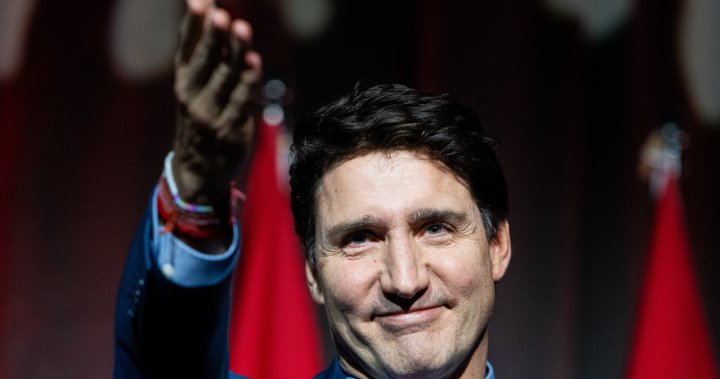Paragraph 1: The Precipice of Change
The Liberal government finds itself in turbulent waters following the unexpected resignation of Finance Minister Chrystia Freeland, an event that has amplified calls for Prime Minister Justin Trudeau’s resignation or a snap election. With the Liberals significantly trailing in opinion polls and the next scheduled election still two years away in 2025, Trudeau faces a crucial juncture in his political career. The party’s prospects for recovery appear dim, leaving the Prime Minister with a critical decision: whether to persevere or relinquish his leadership. The unfolding drama has sparked intense speculation about the various scenarios that could play out in the coming weeks and months, impacting not only the Liberal Party but the entire Canadian political landscape.
Paragraph 2: Navigating the Storm – Trudeau’s Options
Several paths lie before Justin Trudeau, each with its own set of challenges and potential consequences. One option is to swiftly consolidate his cabinet, demonstrating decisive leadership and projecting an image of stability. This would involve appointing replacements for ministers who have already announced their intention to retire and, crucially, reinforcing the Canada-U.S. relations team, signaling a renewed focus on navigating the complex relationship with the incoming Trump administration. This approach aims to reassure his caucus, cabinet, and the Canadian public that he remains in firm control of the government and its direction. Another scenario involves a more deliberate approach, allowing the political fervor surrounding Freeland’s resignation to subside before initiating a cabinet shuffle. This would provide time for strategic planning and potentially allow for a more measured response to the looming threat of U.S. tariffs.
Paragraph 3: The Ticking Clock and the Shadow of Trump
The timing of Trudeau’s next move is critical. With the House of Commons adjourned for the holidays and not scheduled to return until late January, after Trump’s inauguration, the Prime Minister has a limited window of opportunity. If he chooses to resign, a "walk in the snow" moment of reflection, reminiscent of his father’s famous departure, could occur before the House reconvenes. However, delaying action risks further eroding his authority and fueling speculation of a forced exit. The impending Trump presidency adds another layer of complexity, as the new administration’s trade policies, particularly the threatened 25% tariffs, pose a significant challenge for Canada. A strong and stable Canadian government is crucial to navigate these potentially turbulent waters.
Paragraph 4: Prorogation, Leadership Races, and the NDP Factor
Prorogation, the temporary suspension of Parliament, emerges as a tactical maneuver that Trudeau could employ. This would allow him to avoid confidence votes that could trigger an early election, providing breathing room for a potential leadership transition or simply to regroup and strategize. However, past precedent, established through reforms championed by former Liberal MP Peter Milliken, limits the duration of prorogation to prevent its abuse as a tool to indefinitely avoid parliamentary accountability. If Trudeau steps down, the Liberal Party would face the daunting task of organizing a leadership race under a significantly expanded membership base, a legacy of Trudeau’s own reforms. This broader base could lead to a more unpredictable and potentially protracted contest. The NDP, holding the balance of power in the minority government, also plays a pivotal role. Their leader, Jagmeet Singh, has called for Trudeau’s resignation and threatened to trigger an election through a non-confidence vote if he remains in power. This adds another layer of pressure and uncertainty to the Liberals’ already precarious position.
Paragraph 5: The Path to an Election – Confidence Votes and Campaign Logistics
The path to a federal election, whether early or scheduled, hinges on the delicate balance of power in the House of Commons. Confidence votes, typically on budgetary matters, can be initiated by the government or the opposition, and a loss on such a vote would trigger an election. The opposition has a limited number of "opposition days" to bring forward motions, some of which could be framed as confidence votes. The combined opposition parties, the Conservatives, Bloc Québécois, and NDP, would need to unite to defeat the government on a confidence vote, forcing an election. Once an election is called, strict timelines governed by Elections Canada dictate the length of the campaign period (37 to 51 days) and the mandatory Monday election day.
Paragraph 6: The Gridlock Factor and Procedural Maneuvers
The House of Commons has been plagued by gridlock, with procedural tactics and filibusters stalling the government’s legislative agenda. A prominent example is the ongoing debate and filibuster over the release of documents related to an ethics/spending scandal. Prorogation could offer a temporary reprieve from this gridlock, effectively resetting the parliamentary clock and clearing the way for a fresh start. However, unless the underlying issues are resolved, the gridlock could quickly return once Parliament resumes. The Speaker of the House plays a crucial role in managing these procedural battles, and some argue that different procedural decisions could have averted the current impasse. Ultimately, the government’s ability to function effectively, whether under Trudeau or a new leader, depends on finding a way to break the cycle of gridlock and move forward with its legislative priorities.

